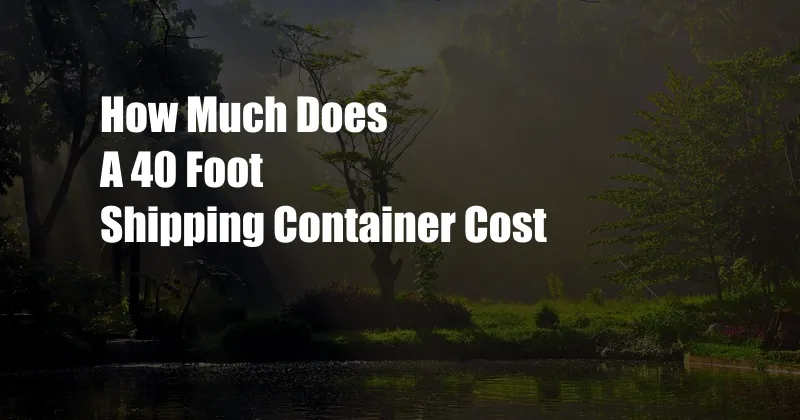
How Much Does a 40 Foot Shipping Container Cost?
It can be a daunting task to ship your belongings or equipment overseas or even across the country. Thus, many people opt for shipping containers, which are a safe and secure way to transport large volumes of goods. However, before you decide on using a shipping container, it’s critical to consider the associated costs. In this comprehensive guide, we delve into the pricing of 40-foot shipping containers, exploring factors that impact their cost and providing expert tips to help you make an informed decision.
Shipping containers have become an indispensable part of global trade, facilitating the efficient and secure transportation of goods across vast distances. Their standardized dimensions and durability make them suitable for diverse industries, including transportation, storage, and construction.
Factors Impacting the Cost of 40 Foot Shipping Containers
The cost of a 40-foot shipping container can vary depending on several factors, influencing the final price you pay.
1. Type of Container
There are two primary types of 40-foot shipping containers: standard and high cube. Standard containers have a height of 8 feet 6 inches, while high cube containers are 9 feet 6 inches tall, providing additional vertical space. High cube containers typically cost more than standard ones, although they offer greater capacity.
2. New or Used
New shipping containers are more expensive than used ones. Used containers may have cosmetic imperfections or minor dents, but they are still structurally sound and suitable for most shipping needs.
3. Location
The cost of shipping containers also varies depending on their location. Containers located in port cities or densely populated areas are typically more expensive than those in remote areas due to higher demand and transportation costs.
4. Market Conditions
The overall market conditions, such as supply and demand, can impact the cost of shipping containers. During periods of high demand or supply chain disruptions, prices may rise.
5. Customization
Customizing a shipping container, such as painting it or adding additional features, can increase its cost.
Latest Trends and Developments
The shipping container industry is constantly evolving, with new trends and developments emerging. One significant trend is the increasing use of digital platforms for booking and tracking shipments, enhancing efficiency and transparency.
Another notable development is the rise of sustainable shipping practices. Many companies are now opting for eco-friendly shipping containers made from recycled materials or equipped with energy-saving features.
Expert Tips for Saving Money
To save money on 40-foot shipping containers, consider these expert tips:
1. Compare Quotes from Multiple Suppliers
Get quotes from various shipping container suppliers to compare prices and find the best deal.
2. Negotiate with Suppliers
Don’t hesitate to negotiate with suppliers to lower the cost. Be prepared to provide justifications for a lower price, such as high volume or long-term contracts.
3. Consider Used Containers
Used shipping containers are significantly cheaper than new ones and can still meet your shipping needs.
4. Explore Rental Options
If you only need a shipping container for a short period, consider renting one instead of purchasing.
5. Look for Discounts
Some suppliers offer discounts for bulk orders or repeat customers.
Frequently Asked Questions
Below are some of the most common questions people have about the cost of 40-foot shipping containers:
Q: What is the average cost of a 40-foot shipping container?
A: The average cost of a 40-foot shipping container can range from $2,500 to $5,000, depending on the factors discussed above.
Q: Are shipping container prices negotiable?
A: Yes, shipping container prices are often negotiable. Contact multiple suppliers and be prepared to negotiate to get the best deal.
Q: What is the difference between a standard and a high cube container?
A: A high cube container is taller than a standard container, providing more vertical space. High cube containers are typically more expensive.
Q: How can I save money on shipping containers?
A: To save money on shipping containers, consider buying used containers, negotiating with suppliers, exploring rental options, or looking for discounts.
Conclusion
Determining the cost of a 40-foot shipping container requires careful consideration of various factors, including container type, condition, location, market conditions, and customization. By understanding these factors, researching the market, and utilizing expert tips, you can make an informed decision that meets your shipping needs and budget. Are you interested in learning more about the cost of shipping containers and how they can benefit your business?